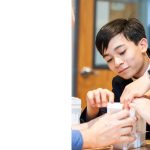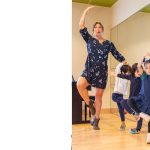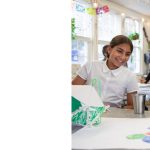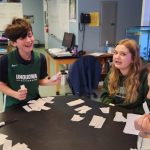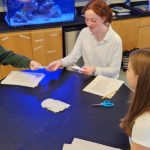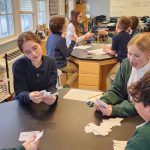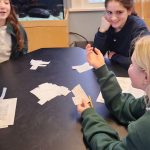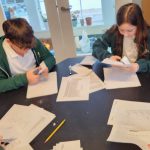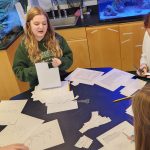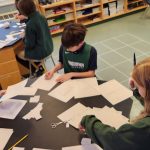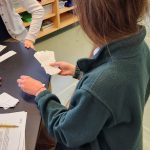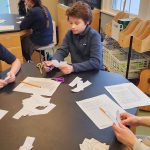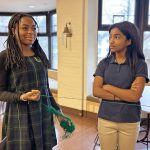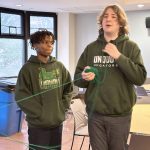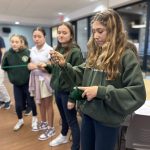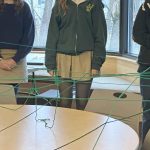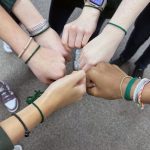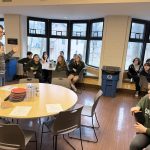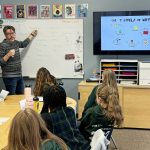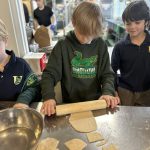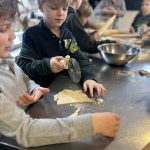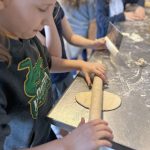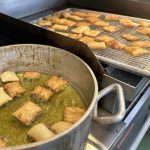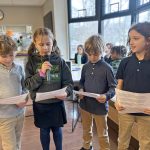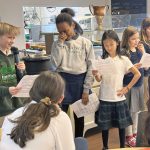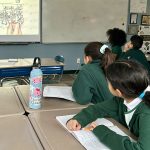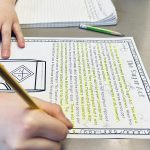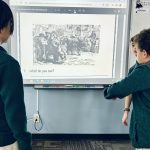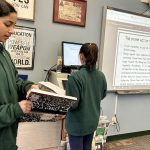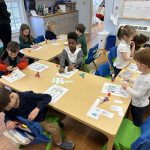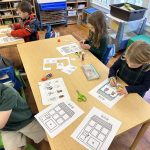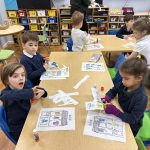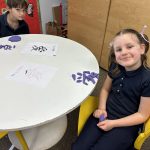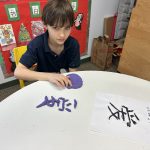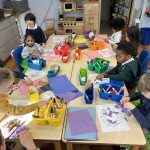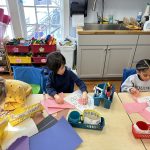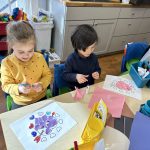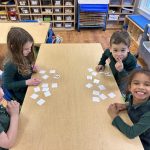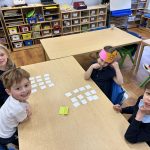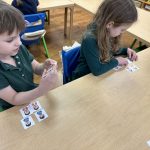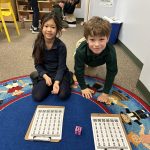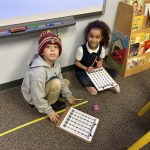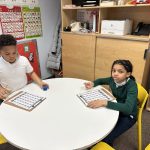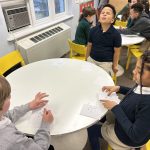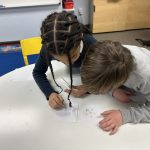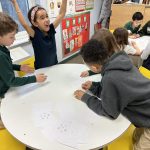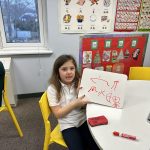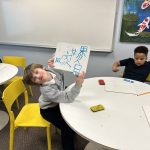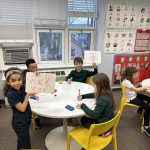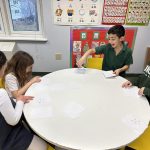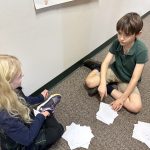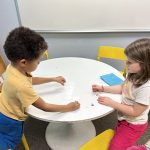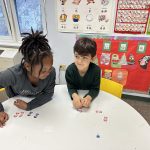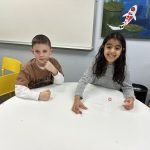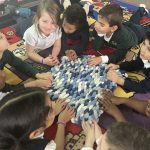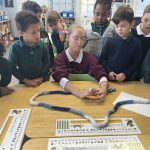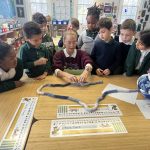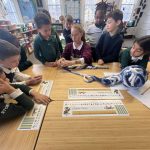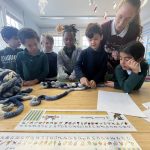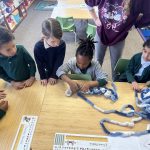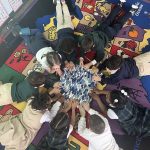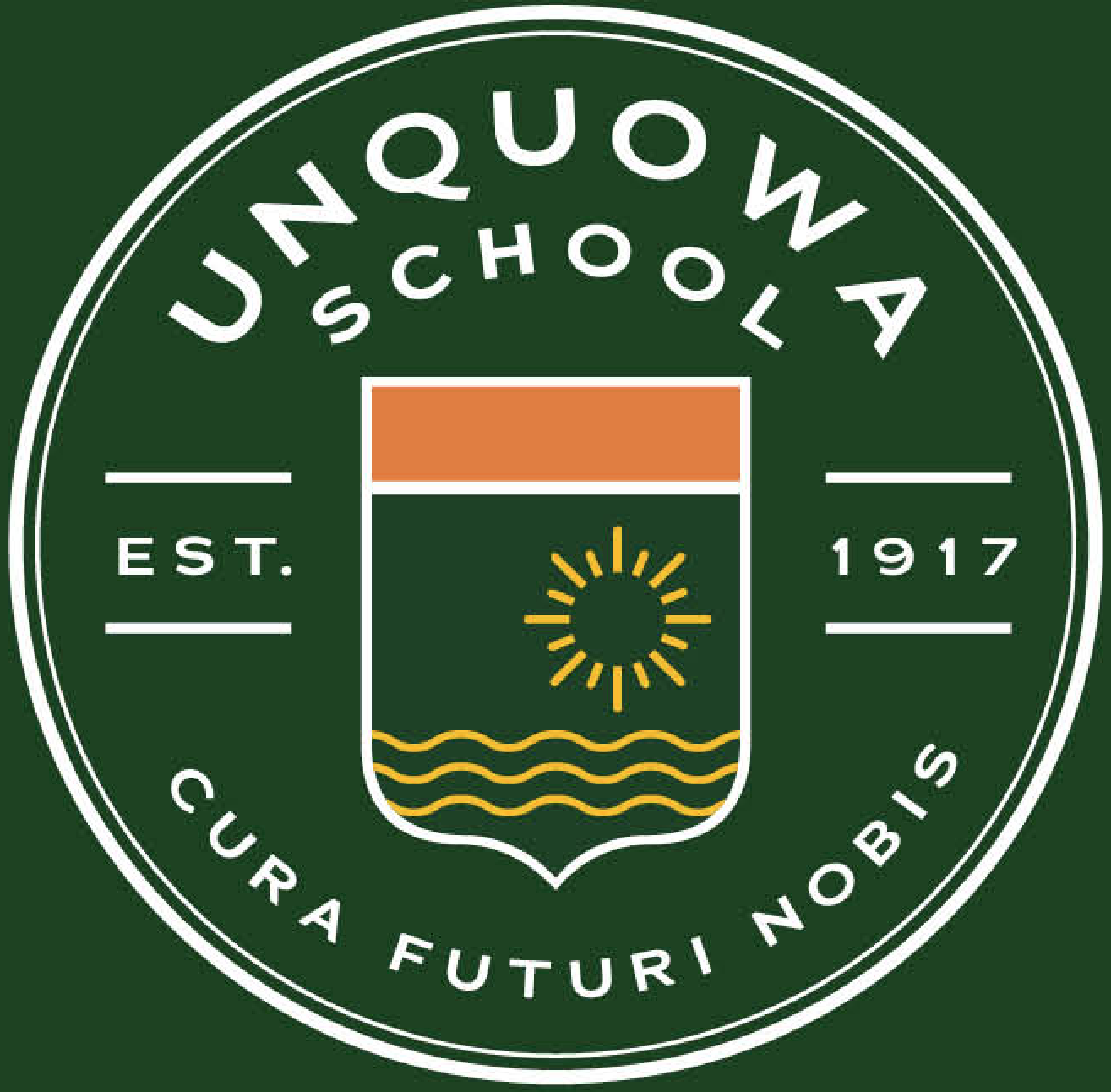Molecules for Life Processes Card Game
Posted by Joshua Bartosiewicz- “I thought I had a set!”
- Handing over a molecule card!
- Excited about the cards they’ve been dealt!
- “Are you sure you don’t have that molecule?”
- Studying the molecules and answering the questions.
- Making their molecule cards.
- Creating their cards.
- Analyzing the molecules on the cards in her hand.
- Starting the game!
All living things are composed of molecules! In this activity and card game, students observed and studied 4 major molecules (lipids, carbohydrates, proteins, nucleic acids) and the elements that make up their structures. The 7th graders had a worksheet to go along with this activity which made them really think about the structures of the molecules. Some questions referred to the number of specific elements in each molecule, if there were any elements present in multiple molecules and more! These questions helped the students to understand that very different types of molecules can share common elements and atoms. After the questions were answered the students cut the molecule structures into separate cards and proceeded to play a game. The game was similar to a combination of “Go-Fish” and matching; students needed to acquire a set of 3 of the same molecules to win the round. Students obtained cards by going around in a circle, one by one and they would ask other players if they were holding a specific molecule in their hand. If the person did in fact have the card that the persons turn asked for, they had to hand it over, if the player did not have the specific card, then the person who asked ends their turn. A student could choose to draw from the deck instead of asking a player for a card if they choose, but they must discard a card when one is drawn. In the end, the students had a great time learning about molecules and their roles in organisms.
Life Worth Living – Workshop Kick-off
Posted by Ariel WarshawOn Friday, February 2nd, 8th graders embarked on their first Life Worth Living workshop, facilitated by Dr. Matthew Croasmun, Director of the Life Worth Living Program at the Yale Center for Faith and Culture, and Unquowa faculty, Eric Snow and Ariel Warshaw. This workshop is part of our Life Worth Living ethics series, which includes 3 full morning workshops, and 5 sessions during Advisory. Prior to this first 3-hour morning program, students had explored elements of their own identity through reflection and guided conversations in Advisory, and then considered how societal perceptions influence their identity and desires.
We kicked off the workshop with a team-building exercise that asked the students to consider an element of their identity, and then pass a skein of yarn to a classmate to do the same. The result? A web of yarn that connected each of us to one another – there were lots of knots, some areas with more or less slack, and places we needed to repair. This served to symbolize our interconnectedness with one another, and how we can overcome challenges within ourselves and between each other. We concluded this exercise by cutting the yarn and tying a piece around our wrists, as a reminder of these lessons.
Dr. Croasmun then shared what brought him to consider, “What is really worth wanting in life?” This opened up to a larger conversation with the 8th graders around the question: “What are things people want?” They brainstormed dozens of responses – money, success, happiness, fame, health – and then considered which of these are “means” versus “ends.” Is money the ultimate goal? Or is it a means to achieve something deeper or more worth wanting, like happiness or security? We finished this portion of the workshop by learning about “The 7 Levels of Why”, which pushed students to ask “why?” from their wants, to delve deeper into their own motivations and desires.
We spent the last part of our workshop engaged in a Reflective Structured Dialogue (RSD). Three simultaneous conversations were held and facilitated by Dr. Croasmun, Eric Snow, and Ariel Warshaw. The students in each group opened the conversation by responding to the question, “What does responsibility mean to you?” Then, 8th graders unpacked the following: “Who determines what is worth wanting in life? Why? To whom am I responsible? To whom are we responsible?” Their responses were incredible – nuanced, deep, full of contradictions at times, and beautifully, imperfectly human.
We finished our workshop by looking at a few philosophical responses to these questions, looking at perspectives from Confucius (responsibility to parents), Asad Tarsinn (responsibility to God or a higher power), and Henry Taylor (responsibility to self).
We will continue to build on the theme of responsibility and the question, “What does good life look like?” over the coming weeks. As 8th graders begin to make decisions around and prepare for high school, the topics we explore will be integral to their thinking around what they truly want and who they truly are. We can’t wait to continue learning and growing with them in this process!
Beignets For All!
Posted by Karen EngelkeGrade 4 continues their study of the 5 regions of the United States. We recently wrapped up our journey of the Southeast. We read about its diverse population and melting pot of customs and cultures. We were drawn to some of the foods we read about so we asked Chef Adam if we could craft a Southeast Lunch. The Chefs created a delicious lunch of crispy chicken fingers with homemade BBQ sauce, roasted corn, vegetarian gumbo and beignets! Beignets which hale from New Orleans are fried dough with a hearty sprinkle of powdered sugar. We happily assisted in the making of the beignets. We also announced both lower school and upper school lunch providing a brief background on each dish.
Who’s Paying For It?
Posted by Trésor KayumbaThe famous French and Indian War, 1754-1763 was a nuanced and complex war. A conflict which had started through diplomatic efforts, but quickly turned. This war is fascinating because it includes many elements of modern war. Big countries fighting over authority, place, while also promising a lot on the conditions that one of the countries win.
5th graders studied about the war as well as the betrayal Native Americans experienced during The Treaty of Paris, 1763. In a class discussion, students were asked to engage in dialogue and offer their perspective on the following question:
Question: Was it fair and just, for the British Parliament to impose taxes on colonies to pay war debts after the French and Indian War? Why or Why Not?
Here are their thoughts…
“Yes, it is fair because Britain paid for the colonists to get to the colonies.”
“I think it is fair to tax the colonists because Britain helped the colonists in the seven years war, but Britain should only tax a reasonable amount.”
“I think that it is okay to tax the colonists because Britain helped them win the war and the money could also go to getting more weapons if there is another war or fight.”
“No it’s not fair because they were working as a team to win, so why would your teammates need to pay you.”
“I think it is fair because they helped them with a war which is a big deal, so I think they should get paid but maybe not soooooo much money.”
“I think it is fair for Britain to tax the colonists because Britain paid a lot of money to win a war for them, but they should consult the colonists.”
I Love My Family!
Posted by kellyyehRecently, in Lower School Mandarin class we learned about family members. We all had fun with many games and activities, including playing spot-it game cards, rolling and reading, making family trees/houses, playing Play-Doh Chinese Characters, writing calligraphy, and singing songs. Through games and activities, students enjoy learning Mandarin and the students did a great job!
Cozy Counting
Posted by Maureen DialloThe first graders paired their math skills along with their craft skills to create a cozy representation of the number 100. Using a hand knitting technique, they worked together to create 10 rows of ten stitches. Each first grader thoughtfully and mindfully completed a row as their classmates helped to count the stitches. We took our math learning a step further and thought about our arrangement of stitches in rows and columns as an array. Arrays are useful representations of multiplication concepts (among other ideas in mathematics)!




